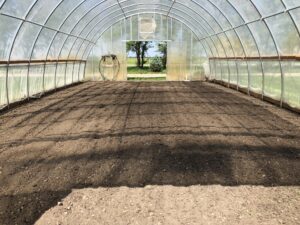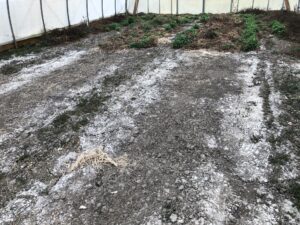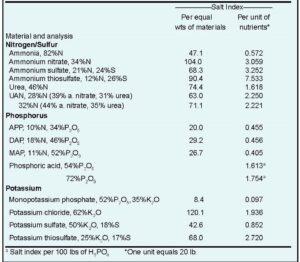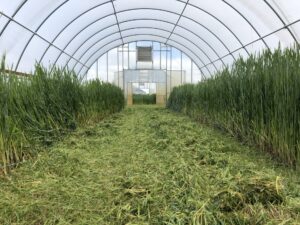High tunnels are essential for every vegetable grower as they can modify the growing environment for crop earliness, protect the crop against environmental stress, reduce disease and insect pressure, and extend the growing season. Growing in a high tunnel is like growing crops in an irrigated desert. Natural rainfall is unavailable inside your high tunnel, and therefore, all your plant’s water needs are satisfied through an irrigation system. The lack of precipitation inside the high tunnel impacts production management processes, particularly soil fertility management. In this article, I will discuss why analyzing your irrigation water source and soil is critical.
Test your soil and water
Soil and water test results are crucial to designing a management plan that ensures long-term soil health and high productivity. Do soil sampling before seedlings are set, preferably at the same time every year, in case you want to do a comparative analysis in the future. If your water source is a well or pond, I strongly recommend submitting a sample for analysis to your closest laboratory. Water composition at the beginning of the growing season can differ significantly from water tested later in the growing season. In this case, doing an analysis several times during the production season will be appropriate.
Water alkalinity
One of the significant issues with well water in Indiana is that it is sometimes very alkaline. Alkalinity (as CaCO3) measures the combined amount of carbonate, bicarbonate, and hydroxide ions in the water, and it describes the ability of water to neutralize acids. In other words, it buffers water against pH changes. Water that helps to buffer against pH changes is excellent, but too-high alkalinity will increase the incidence of dripper clogging and increase root zone pH over time. The combination of high alkalinity and pH can cause plant nutritional disorders. Usually, the optimum alkalinity range for plants is between 30 to 60 ppm (or mg·L-1) (can be a source of calcium and magnesium), and the desired content for irrigation water is 0 to 100 ppm. Some laboratories report alkalinity in milli-equivalents (meq·L-1). Alkalinity of 50 ppm CaCO3 is equal to 1 meq·L-1. Always include alkalinity and pH in your irrigation water test. pH by itself is not indicative of alkalinity.
Managing high alkalinity
Amending your water alkalinity and pH while you irrigate is the fastest and most cost-effective method to manage soil pH. Acid injection into irrigation water (to pH 5.8) or using an acidic fertilizer can help remedy the situation. Although fertilizers with a high potential acidity usually contain a high percentage of ammonical nitrogen and urea. A few sources of acid are available on the market: sulfuric acid is very affordable (adds sulfur), phosphoric acid can potentially add a lot of phosphorus, and nitric acid (adds nitrate) is very acidic and has harmful fumes. Exercise caution when working with acids. Also, consider that the source of acid used can provide specific nutrients. Citric acid (approved for organic growers) is the only source that does not supply additional nutrients.
A handy tool to calculate how much acid is needed is ALKCALC. All you need to complete the form is the water’s pH and alkalinity content, the type of acid you want to use, and your target alkalinity level. When using drip irrigation, the pH between rows will remain high. To affect the entire high tunnel, use sprinkler irrigation to flood the whole tunnel when no crops are present. If you want to acidify your soil slowly with an organic amendment, apply elemental sulfur at 10 to 15 lb/1000 sq. ft. of bed area for each 0.5 pH unit drop needed (Mickelbart and Stanton, 2012; Sideman, 2018).
Other important water quality issues
Make sure that iron, manganese, and sulfate concentrations in the water are within acceptable ranges. Iron levels above 5 ppm could be toxic to the plant and result in iron precipitates forming at the emitter, plugging your irrigation system. Similarly, manganese levels above 1.5 ppm and sulfate levels above 240 ppm could cause emitter blockage. Keeping track of the sodium and chloride levels in the water is also essential. High levels (>50 ppm Na and >70 ppm Cl) can increase soil salinity, especially in the top 2-4 inches, and therefore must be managed carefully. Particularly given the high tunnel cover preventing natural rainfall from washing or leaching excess soluble salts from the soil.
Soil testing
The optimum values reported below can differ for different vegetable crops.
The optimum pH varies by crop. Still, it is generally accepted that the ideal pH range for organic and mineral soils is 5.3 to 5.8 and 6.0 to 7.0, respectively. In mineral soils, nitrogen, phosphorus, potassium, calcium, magnesium, boron, and molybdenum are most available when the pH is between 6.0 and 7.0. With a soil pH below 6.5, zinc, manganese, iron, and copper are the most available. It is, therefore, desirable to maintain mineral soil pH between 6.0 and 6.5. The available aluminum increases as the mineral soil pH decrease, especially below 5.5. The increasing aluminum concentration can further contribute to soil acidification and aluminum toxicity, which inhibits root growth. The lower pH range is acceptable for organic soils (5.3 to 5.8) because aluminum levels are very low (Warncke et al., 2004).
The capacity of soil to hold exchangeable cations is measured and reported as the cation exchange capacity (CEC) of the soil. This value is a good indicator of soil fertility. Good soil has a CEC between 5 and 35 meq/100g soil. Generally, sandy soils have a low CEC, and soils with a high CEC are likelier to have a high clay or organic matter content. The optimum soil organic matter content for vegetables is 3% to 6% or higher.
Two tests are performed to determine the phosphorus levels, P1 (weak Bray) and P2 (strong Bray). The P1 test is an indication of the phosphorus that is readily available to plants (20 to 50 ppm is adequate), and the P2 test confirms the level of phosphorus that is available and part of the active reserve in the soil (40 to 60 ppm is a desirable level).
Potassium should be in the range of 150 to 300 ppm, calcium 1000 to 2500 ppm, and magnesium >50 ppm.
Soluble salt results are presented as the electrical conductivity (EC) of the soil and are measured in mmhos/cm. An EC <1.0 (<640 ppm salt) is considered good, and an EC >2.5 (>1600 ppm salt) is unsuitable for crops.
Percent base (cation) saturation indicates what proportion of the CEC is occupied by cations such as Ca2+, Mg2+, and K+. Optimum ranges for Ca2+, Mg2+, and K+ are 40-80%, 10-40%, and 1-5%, respectively.
Micronutrient ranges for vegetable crops are between 1 to 3 ppm Zn, 1 to 5 ppm Mn, 11 to 16 ppm Fe, 0.5 to 1.5 ppm Cu, 0.7 to 1.0 ppm B, and 0.11 to 0.20 ppm Mo.
Soil salinity
The lack of rainwater to flush soluble salts can increase soil salinity. An increasing salt concentration in the soil also leads to increases in alkalinity. This can affect crop growth negatively and can be prevented and managed through a carefully planned soil fertility plan. Soluble salts can be introduced through irrigation water and soil amendments such as fertilizer (sodium nitrate, calcium nitrate, potassium nitrate, potassium chloride, etc.), composts, and manures. Dependent on the feedstocks used to make the compost, it can contain high amounts of salts and phosphorus. High tunnels tend to elevate soil temperatures inside the tunnel, which could increase soil microorganism activity, releasing nutrients from organic materials such as manures and composts faster into the root zone. The over-application of soil amendments leads to excess nutrients that are leached through the soil profile or build up in the root zone or near the soil surface.
How does soil salinity affect plants?
Plant sensitivity to salinity differs. Some plants are more tolerant or sensitive than others (Figure 3). Sensitive plants could exhibit scorched leaf margins, leaf tip burning, or yellowing. Leaf tissue analysis can help to confirm whether these symptoms are due to salinity or other nutrient imbalances. Yield loss is of great concern in saline soils.
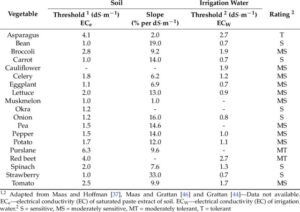
Figure 3. Soil Salinity: Effect on Vegetable Crop Growth. Management Practices to Prevent and Mitigate Soil Salinization (Machado, R. and R. Serralheiro, 2017).
Prevention and remediation
Limit the amount of soil amendments (composts, manures, nitrogen-based fertilizers) applied to the soil. Use the soil test results and expected yield (plant nutrient removal) to calculate appropriate application rates. Split application rates and use fertilizer sources with a low salt index (Figure 4). If possible, add cover cropping to your rotation in the tunnel. Cover crops are great tools to improve soil organic matter (instead of using compost) and scavenge nutrients (Figure 5). Think about what you want to improve or remediate in the high tunnel and select cover crops that can assist in achieving that goal. Water management is a great and easy way to manage and improve soil salinity. Use overhead irrigation to irrigate the entire soil surface in the high tunnel. Apply as much as 12 inches of water. An even easier solution might be to leave the tunnel uncovered during the rainy season. Every 4 to 5 years, you have to replace the plastic cover on the high tunnel. Plan to leave the cover off during the rainy season. Consider doing this during the fall/winter when growing anything in the tunnel is hard.
In summary
- Test your soil and irrigation water.
- Ask the lab to provide recommendations or calculate your fertility needs.
- Amend your irrigation water according to test results.
- Select fertilizer salts carefully and limit the amount applied at one time.
- Use caution when applying manure-based compost.
- Plan to include cover crops in your crop rotation.
- Plan not to limit irrigation through drip lines only. Apply overhead irrigation to leach excess salts.
- Select crops that are tolerant to specific salinity conditions.
Resources
Langenhoven, P. 2019. Basic Aspects of High Tunnel Soil Fertility Management. https://vegcropshotline.org/article/basic-aspects-of-high-tunnel-soil-fertility-management/
Machado, R. and R. Serralheiro. 2017. Soil Salinity: Effect on Vegetable Crop Growth. Management Practices to Prevent and Mitigate Soil Salinization. Horticulturae. 3(2). 13. 10.3390/horticulturae3020030.
Mickelbart, M.V. and J.J. Camberato, K.M. Stanton and S. Hawkins, 2012. Commercial Greenhouse and Nursery Production: Lowering Soil pH for Horticulture Crops (HO-241-W). https://mdc.itap.purdue.edu/item.asp?Item_Number=HO-241-W
Midwest Vegetable Production Guide. https://mwveguide.org/
Mortvedt, J.J. 2001. Calculating Salt Index. https://fluidfertilizer.org/wp-content/uploads/2016/05/33P8-11.pdf
Sideman, B. 2018. High Tunnel Soil Management Update. UMass Extension. Vegetable Notes, Vol. 30 No. 2. https://ag.umass.edu/sites/ag.umass.edu/files/newsletters/february_15_2018_vegetable_notes.pdf
Warncke, D., J. Dahl and B. Zandstra. 2004. Nutrient recommendation for Vegetable Crops in Michigan. Michigan State University, Extension Bulletin E2934. http://msue.anr.msu.edu/resources/nutrient_recommendations_for_vegetable_crops_in_michigan_e2934
